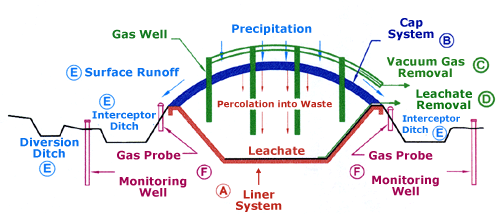|
Landfills, such
as the one that BVSWMA operates, are considered to be
sanitary and better for the environment. The holes are
dug, then barriers, filters, and liners are placed,
trash is put in and a layer of earth is used to cover
the trash. Because of these barriers, pollution from the
trash does not seep into the ground and scavenger pests
are reduced. This type of landfill is called a
Subtitle D Landfill.

- LINER SYSTEM
Multiple, engineered layers of
geosynthetic and natural soil materials underlying the
disposal area, and preventing rainfall and other
liquids that come in contact with the waste from
escaping into the environment and restricting the
underground migration of landfill gases.
- CAP SYSTEM
A vegetated cover placed over
the landfill at completion of filling, consisting of
geosynthetic and natural soil materials, preventing
the escape of landfill gases to the air and
restricting the infiltration of rain into the
landfill.
- GAS MANAGEMENT SYSTEM
A series of extraction wells and
piping that removes methane and other decomposition
gases from the landfill for proper destruction and
reuse.
- LEACHATE MANAGEMENT
SYSTEM
A series of pipes placed beneath
the waste (and above the liner system) that remove
leachate from the landfill for proper
treatment.
- EROSION AND
SEDIMENTATION CONTROLS
A network of storm water
drainage channels and detention ponds, which remove
rainfall from the surface of the landfill before it
comes into contact with the waste, and prevents storm
water from flowing onto the landfill from surrounding
areas.
- MONITORING
SYSTEMS
A comprehensive system of
environmental monitoring locations and devices to
promptly detect releases to air, surface water and
groundwater resources, and to ensure protection of
public health, safety and the environment.
| 


